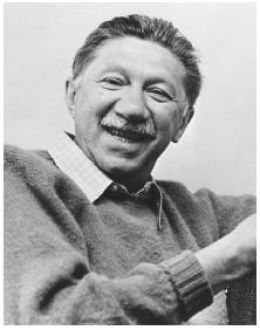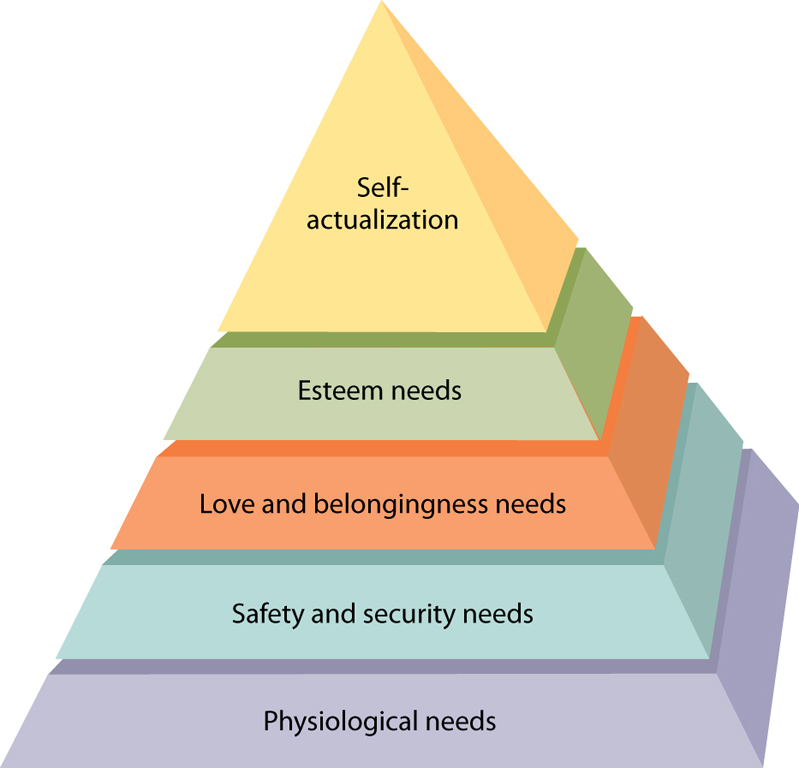Motivation
PSYC 1301
Motivation
Motivation and emotion help guide our behavior. Both motives and emotions move us toward some action. Motivation is the urge to move toward specific goals. Motivation explains why we act the way that we do. Motives are specific inner needs or wants that arouse an organism and direct its behavior toward a goal. Motives can be divided into three categories:
- basic biological motives necessary for survival,
- social motives such as physical and psychological needs, and
- curiosity.
Emotions are experiences of feelings such as fear, joy, or surprise, which also underlie behavior.
Perspectives on Motivation
At the turn of the twentieth century, psychologists believed that motivated behavior was caused by instincts, specific inborn, inflexible, goal-directed behavior that is characteristic of an entire species. The problems with this theory, however, were that psychologists could not agree on what the basic instincts were, and instincts cannot explain learned behaviors.
Drives are states of tension that occur when our bodies are deficient in some ways. These drives are compelled by needs that are inherently biological - either cellular or bodily needs.
Motivation Models
Drive-Reduction Model
The Drive-Reduction Model viewed motivated behavior as a strategy to ease an unpleasant state of tension or arousal (a drive) and return the body to a state of homeostasis. Homeostasis is the body's attempt to achieve a state of balance in which the body functions effectively around an optimal set point. This Drive Reduction Model, however, cannot explain why some people work harder for some goals than others or why humans, such as yourself, seek to acquire knowledge.
Optimal Arousal Model
Emotions, like motives, both arouse and direct our behavior. They tend to prompt us to move toward or away from an object or person. However, also like motives, emotions may trigger a complex chain of behavior that may promote or interfere with the accomplishment of our goals. According to the Yerkes-Dodson law, the more complex the task, the lower the level of emotional arousal that can be tolerated without interfering with performance. Moderate levels of arousal lead to optimal performance.
We are motivated to be in situations that are optimally arousing. Researchers believe that needs such as curiosity, learning, interest, aesthetics, competence, challenge, and optimal experiences are all motivated by the desire to be optimally aroused.
|

Abraham Maslow
|
The Hierarchical Model
Abraham Maslow believed all humans have an innate drive toward self-actualization. He suggested that the various motives, learned and unlearned, social and primary drives, can be arranged in a hierarchy. The lower motives spring from bodily needs that must be satisfied for survival; the higher motives, such as the striving to belong or to achieve self-esteem, do not emerge until the more basic motives have largely been satisfied. In other words, self-fulfillment would not be a number-one priority for someone in a war-torn country who had to dig in the trash for food. As a person was able to meet his needs for survival, he would seek to move up the ladder of needs toward self-actualization.
|
Maslow's Hierarchy of Needs
|

|
- Lower level needs are arranged in a hierarchy
- Physiological needs (e.g., food, water, oxygen, and adequate body temperature)
- Safety/security needs (e.g., physical security, stability, dependency, protection, and freedom from threats such as war, assault, and terrorism)
- Belongingness and love needs (e.g., friendship, sex, spouse, children, family or social groups)
- Esteem needs (e.g., to be able to appreciate oneself and be appreciated and respected by others)
- Cognitive needs
- Aesthetic/Beauty needs
- Self-actualization (e.g., the full realization of one's potential and abilities in life)
|
What would be your definition of a person who has attained self-actualization or fulfillment? On the next page are Maslow's characteristics so you will know when you have reached that height.
Self-actualized persons....
|

Well, what do you think of this list? Do you know anyone that meets Maslow's description of a self-actualized person?
|
- perceive reality clearly and are comfortable with uncertainty.
- accept themselves and others for what they are.
- are spontaneous in behavior, motivated by the attempt to develop their own style.
- are problem-centered rather than self-centered, focusing on accomplishing unselfish tasks.
- enjoy solitude and make decisions privately.
- maintain an inner serenity in unpleasant circumstances and when dealing with social pressures.
- have a continued freshness of appreciation and do not take things for granted.
- experience peak experiences, or feelings of transcendence and intense joy, in basic experiences of life.
- affectionately identify with other people.
- establish deep, satisfying interpersonal relationships with a few, rather than many, people.
- are democratic and unprejudiced in dealing with others.
- are strongly ethical in behavior as well as attitudes.
- have a spontaneous, non-hostile sense of humor.
- are creative.
- resist enculturation, although they are not purposely unconventional.
|
Hunger : Survival of the Individual
Hunger is primarily regulated by two centers in the brain: the hunger center, which stimulates eating, and the satiety center, which reduces the feeling of hunger and tells us we are "full." Whenever the level of the simple sugar glucose in the blood falls to a certain point, neurons in the hunger center are stimulated. Receptors in the stomach and a hormone released by the small intestine also send signals to the brain. Another hunger regulator monitors long-term body weight. Both the motivation to eat and overeating are influenced by biological, psychological, cultural, and environmental factors. The drive-reduction perspective says that being hungry depends on how much food we have consumed recently and how much energy is available for organ function.
Thirst parallels hunger in that both internal and external cues can trigger the thirst drive. Dehydration both inside and outside the cells prompts activation of the thirst drive, so do weather conditions as well as social, psychological, and cultural influences, and other external stimuli.
|

|
The psychology of what we eat is determined by external factors such as the sight and smell of foods, and cultural preferences. Genetic factors also play a major role in determining who is thin and who is overweight. But, we are a nation that places a high premium on thinness. This motive to be thin has lead to an increase in eating disorders. At first, eating disorders were associated with young females, but now eating disorders affect both genders and can occur across the life span.
|
Anorexia nervosa is a serious eating disorder associated with an intense fear of weight gain and a distorted body image. Another eating disorder, known as bulimia, is characterized by binges of eating followed by self-induced vomiting. Eating disorders are notoriously difficult to treat, especially in a culture obsessed with dieting. For more information on anorexia nervosa or bulimia, see the web sites for The National Association of Anorexia Nervosa and Associated Disorders and National Eating Disorders Association.
Needs to Belong and Excel
Affiliation
The affiliation motive, the need to be with other people, is especially pronounced when people feel threatened. But we may also choose to get together with others to obtain positive feedback or to give us the physical contact we crave. Affiliation, the desire to be accepted by others, is one of the strongest human needs.
Achievement
The achievement motive, a learned social motive, underlies the desire to excel, to overcome obstacles, and to strive to do something difficult as well as possible. Atkinson (1964) posits that the motivation to succeed is driven by the expectation of success and the incentive value of success. The need for achievement, which varies among individuals, has been measured using the Thematic Apperception Test (interpretations of drawings) and the Work and Family Orientation Scale, a questionnaire that measures work orientation, mastery, and competitiveness. It has been found that a high degree of competitiveness may actually interfere with achievement.
Stimulus Motives
Like primary drives, stimulus motives are largely unlearned. Stimulus motives place a premium on obtaining information about the environment and depend more on external stimuli than on internal states.
Exploration and Curiosity
Exploration and curiosity are motives activated by the unfamiliar and are directed toward the goal of discovering how the world works. Psychologists disagree on the nature and causes of curiosity, but it has been linked to creativity.
Manipulation and Contact
Humans and primates need to manipulate objects to gain both tactile information and a sense of comfort.
Contact, the need for affection and closeness, is another important stimulus motive. Although manipulation requires active "hands-on" exploration, contact may be passive.
Other Important Motives
As we develop, our behavior is governed by a number of new motives strongly influenced by learning: aggression and the social motives - achievement, power, and affiliation - which center on our relationships with others.
Any behavior that is intended to inflict physical or psychological harm on others is an act of aggression. Some psychologists consider aggression part of an unlearned instinct that is triggered by pain and frustration; others see it as an innate drive that must be channeled into constructive avenues. Many contemporary psychologists believe aggression is a learned response, modeled after the aggressive behavior of others.
Cultural differences in aggressiveness are reflected in statistics on violent crimes. Individualist cultures, which value personal independence, tend to be high in crime, whereas collectivist cultures, emphasizing interdependence and group cohesion, tend to be lower. Research has also linked the dimension of individualism/collectivism to how various cultures interpret aggressive behavior.
Across cultures and at every age, males are more likely than females to behave aggressively both in verbal and physical ways. Both biological and social factors appear to contribute to these gender differences.

Emotion
Emotions, like motives, both arouse and direct our behavior. They are brief, acute changes in conscious experiences and physiology that occur in response to a personally meaningful situation. Emotions tend to prompt us to move toward or away from an object or person. While drives are aligned with specific needs, emotions are not.
Affect is the variety of emotional phenomena including emotions, moods, and affective traits. Moods are affective states that operate in the background of consciousness. Affective traits are stable predispositions toward certain types of emotional responses such as anger.
Basic Emotions and the Dimensions of Affect
Basic emotions common to all humans include anger, fear, disgust, happiness, sadness, and surprise. An emotion family is a broad category, such as fear, and all the specific emotions related to fear such as anxiety and nervousness.
Robert Plutchik's classification system for emotions uses a "circle" to position eight basic categories of emotions that motivate various kinds of adaptive behavior. However, not all cultures view or categorize emotions this way; some do not even have a word for emotion. Others describe feelings by their physical sensations.
A cross-cultural analysis of emotional expression has led Paul Ekman and his colleagues to argue for the universality of at least six emotions: happiness, surprise, sadness, fear, disgust, and anger. Many psychologists also add love to this list of basic emotions. This neuro-cultural theory, however, proposes that the regulation of emotion may be different across cultures.
Self-Conscious Emotions
Self-conscious emotions include shame, guilt, pride, humiliation, embarrassment, and any other emotion that occurs as a function of how well we live up to our expectations or the expectations of others.
Theories of Emotion
The first modern theory of emotion was formulated by James. According to the James-Lange Theory, environmental stimuli bring on physiological changes in our bodies, and emotions then arise from those physical changes. Our sensory receptors send information to the brain, which sends signals to the body. We feel the sensation as emotion. The role of cognition or thought is not addressed. In other words, we feel sad because we cry.
The cognitive theory of emotion holds that the situation that we are in when we are aroused, the overall environment, gives us clues that help us interpret this general state of arousal.
Expression of Emotion
Emotions can create changes in vocal intonation, body language, and facial expressions.
Verbal Communication
What people say about what they are feeling often does not accurately reflect their emotions.
Nonverbal Communication
Facial expressions are the most obvious nonverbal emotional indicators. Body language, our posture, the way we move, our preferred personal distance from others when talking to them, also expresses emotion. Explicit acts, such as slamming a door, are clues to someone's emotional state. People vary in their sensitivity to nonverbal cues.
Display rules are culture-specific standards that govern how, when, and why facial expressions of emotion are shown. The first empirical support for display rules came from a study comparing disgust expression in American and Japanese students.
To return to the session, close this lecture window or tab.




